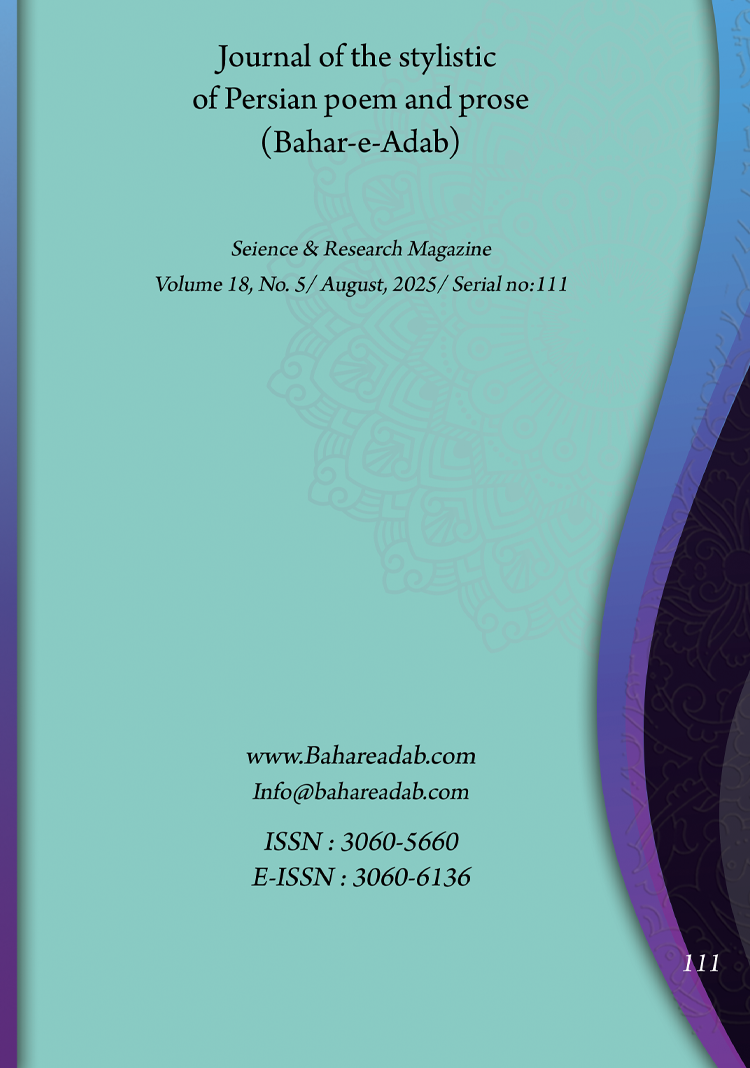- Count View : 9
- آدرس کوتاه شده مقاله: https://bahareadab.com/article_id/1863
- کد doi مقاله: Doi: 10.22034/bahareadab.2025 .18 .7889
Journal of the stylistic of Persian poem and prose
volume Number 18،
number In Volume 5،
،
issue Number 111
A Socio-Semiotic Analysis of the Representation of Women in Four Bestselling Novels from the First Decade after the Iran–Iraq War: Focusing on the Elements of Superstition, Religion, and Nationalism
Narges Kazemizadeh (Author in Charge)
Abstract
BACKGROUND AND OBJECTIVES: This study employs a socio-semiotic framework to examine the representation of women in four bestselling Persian novels published during the first decade following the Iran-Iraq War (1988–1997). These novels prominently feature three cultural elements—superstition, religion, and nationalism—that contribute to the reproduction of dominant patriarchal discourses.
METHODOLOGY: Using qualitative content analysis informed by social semiotics, literary sociology, and feminist criticism, the study analyzes textual data extracted from four bestselling novels (Bamdad-e Khomar, Golab Khanom, Goli dar Shurezar, and Bazgasht be Khoshbakhti). The analysis is conducted at linguistic, visual, and discursive levels.
FINDINGS: Findings reveal that superstitious motifs (e.g., divination, dreams, candle lighting), religious practices (such as temporary marriage, invocation, pilgrimage), and nationalist symbols (including Nowruz, Chaharshanbe Suri, and wedding ceremonies) are extensively employed in the characterization of female figures. These elements predominantly function to reinforce traditional gender roles, strengthen patriarchy, and legitimize the prevailing cultural order.
CONCLUSION: Rather than reflecting social transformation or critiquing cultural norms, bestselling novels of the post-war decade primarily serve to reproduce traditional discourses and validate existing social structures. This study illustrates how popular literary texts can operate as instruments for the consolidation of social, gender, and cultural norms.
Keyword
Representation of women
, cultural semiotics
, superstition
, religiosity
, nationalism
, bestselling novels
, content analysis
- Haj Seyed Javadi, F. (2019). Bamdad-e Khomar. Tehran: Alborz.
- Farast, Q. (2016). Golab Khanom. Tehran: Ghadir.
- Sameni, N. (1995). A flower in the salt land. Tehran: Ketab.
- Rahimi, F. (1994). Return to happiness. Tehran: Pegah.
- Scarpit, R. (2013). The sociology of literature (M. Kotobi, Trans.). Tehran: SAMT.
- Bagheri, N. (2008). Women in fiction. Tehran: Morvarid.
- Pouyandeh, M. J. (1998). Introduction to the sociology of literature. Tehran: Naghsh-e Jahan.
- Duverger, M. (1996). Methods of social sciences (K. Asadi, Trans.). Tehran: Amir Kabir.
- Asgari Hasan Kalo, A., & Rakowitzka-Asgari, K. (2016). Voice of the times: A sociology of female characters in post-revolutionary novels. Tehran: Akhtaran.
- Tajaddod, Z., Alavi Moghaddam, M., Firouzi Moghaddam, M., & Sadeghi Manesh, A. (2024). A study of realistic elements in popular novels within the framework of rhetoric and ideology in feminine writing: Case study: Return to Happiness by Fahimeh Rahimi. Research Journal of Persian Language and Literature, University of Mazandaran, 15(2), 1–25.
- Rasouli, Y., & Taheri, H. (2021). A study of the structural and content changes of popular novels in Iran based on selected novels. Contemporary Literature, 12(3), 55–78.
- Sanati, N., Jahani, E., Chavoshian, H., & Sanati Sharghi, H. (2020). The conceptual space of love in Iranian novels: Popular and literary in the 1380s. Studies in Persian Language and Literature, 5(2), 87–110.
- Anderson, B. (1983). Imagined communities: Reflections on the origin and spread of nationalism. London, UK: Verso.
- Anthias, F., & Yuval-Davis, N. (1989). Woman-nation-state. London, UK: Palgrave Macmillan.
- Butler, J. (1990). Gender trouble: Feminism and the subversion of identity. New York, NY: Routledge.
- Geertz, C. (1973). The interpretation of cultures. New York, NY: Basic Books.
- Klein, D. J. K. (2006). The sociology of superstition. London, UK: Routledge.
- McClintock, A. (1995). Imperial leather: Race, gender and sexuality in the colonial contest. New York, NY: Routledge.
- Yuval-Davis, N. (1997). Gender and nation. London, UK: Sage Publications.

